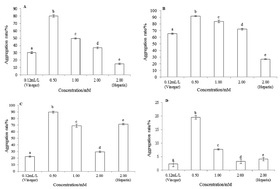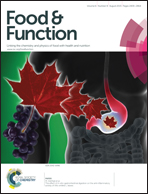Acetic acid in aged vinegar affects molecular targets for thrombus disease management†
Abstract
To elucidate the mechanism underlying the action of dietary vinegar on antithrombotic activity, acetic acid, the main acidic component of dietary vinegar, was used to determine antiplatelet and fibrinolytic activity. The results revealed that acetic acid significantly inhibits adenosine diphosphate (ADP)-, collagen-, thrombin-, and arachidonic acid (AA)-induced platelet aggregation. Acetic acid (2.00 mM) reduced AA-induced platelet aggregation to approximately 36.82 ± 1.31%, and vinegar (0.12 mL L−1) reduced the platelet aggregation induced by AA to 30.25 ± 1.34%. Further studies revealed that acetic acid exerts its effects by inhibiting cyclooxygenase-1 and the formation of thromboxane-A2. Organic acids including acetic acid, formic acid, lactic acid, citric acid, and malic acid also showed fibrinolytic activity; specifically, the fibrinolytic activity of acetic acid amounted to 1.866 IU urokinase per mL. Acetic acid exerted its fibrinolytic activity by activating plasminogen during fibrin crossing, thus leading to crosslinked fibrin degradation by the activated plasmin. These results suggest that organic acids in dietary vinegar play important roles in the prevention and cure of cardiovascular diseases.


 Please wait while we load your content...
Please wait while we load your content...